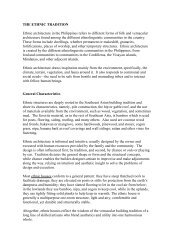THE ETHNIC TRADITION IN PHILIPPINE MUSIC ... - About Philippines
THE ETHNIC TRADITION IN PHILIPPINE MUSIC ... - About Philippines
THE ETHNIC TRADITION IN PHILIPPINE MUSIC ... - About Philippines
Create successful ePaper yourself
Turn your PDF publications into a flip-book with our unique Google optimized e-Paper software.
in most of the life-cycle and occupational activities and rituals, especially those<br />
conducted or led by elders, priests, and shamans. On these occasions, there is<br />
only a vague distinction between religious and secular expressions. Islamic rites<br />
include the Salathul Juma (Friday prayer), the Tarawe (prayer during the<br />
Ramadan), and the Maranao dekir or Maguindanao dikil (a dirge sung on the last<br />
night of the vigil). An extensive repertoire of vocal music celebrates major<br />
religious periods of the Christian liturgical year: Christmas, Lent, Easter, May<br />
Festival, All Saints’ Day, and the feast days of saints. During Christmas, Joseph<br />
and Mary’s search for lodging is reenacted in the panunuluyan; the villancicos and<br />
the Cebuano daigon are the traditional carols sung inside and outside the churches<br />
during the entire season.<br />
The pasyon, which is chanted during the pabasa using traditional tunes like the<br />
awit and tagulaylay, is the musical centerpiece of the Lenten season. The pasyon<br />
also provides the musical material to the passion play or sinakulo. The “Regina<br />
Coeli, Laetare” (Queen of Heaven, Rejoice), is sung during the salubong, a pageant<br />
depicting the first meeting of the risen Christ and the Virgin Mary. During the<br />
santacruzan in May, the “Dios te salve” is sung during the processions. The<br />
Batangas Tagalog perform the subli. May procession songs in Bicol include the<br />
aurora, kristiyanong turog, dotok, gozo, and dalit.<br />
There are rituals in which vocal music plays a significant role: curing ceremonies,<br />
such as the Batak and Subanon diwata, Bontoc kapya, Ibaloy angba, and Ilongot<br />
dawak; supplication rituals and offering of sacrifice such as the Kankanay alasan<br />
and Tagalog sanghiyang; the Ibaloy bendiyan to celebrate victory in headhunting<br />
or tribal war like the Kalinga kayuyugan and Manobo pamansag; peace pacts,<br />
which are celebrated with the oggayam, ullalim, and dango; and thanksgiving rites<br />
like the Manobo pangangando.<br />
There are children’s songs, songs for fun, like the Subanon bongotat which is<br />
about old age and falling hair, drinking songs, greeting songs, and farewell songs.<br />
Philippine oral literature is also rich in extended narrative forms such as the folk<br />
epics and the metrical romances. The epics express not only the historical and<br />
literary aspects of a cultural tradition but also the people’s beliefs and entire<br />
system of social values. Some representative Philippine epics are the Bilaan<br />
Aflulok, the Ifugao Hudhud, the Ilocano Lam-ang, the Sulod Hinilawod, the<br />
Palawan Kudaman, the Maguindanao Rajah Indarapatra, the Maranao<br />
Darangen, the Manobo Tuwaang, Agyu and Ulahingan, the Mansaka<br />
Manggob, and the Subanon Gambatutu (Maceda 1972; Pfeiffer 1975:204-248).<br />
Some epics are shared by two or more cultural groups, such as the Rajah<br />
Indarapatra, known to both the Maguindanao and the Maranao.<br />
In most Christian communities, the epics have been replaced by metrical romances<br />
introduced by the Spanish colonizers. The popularity of metrical romances<br />
peaked in the 19th and early 20th centuries. Although the stories were originally







